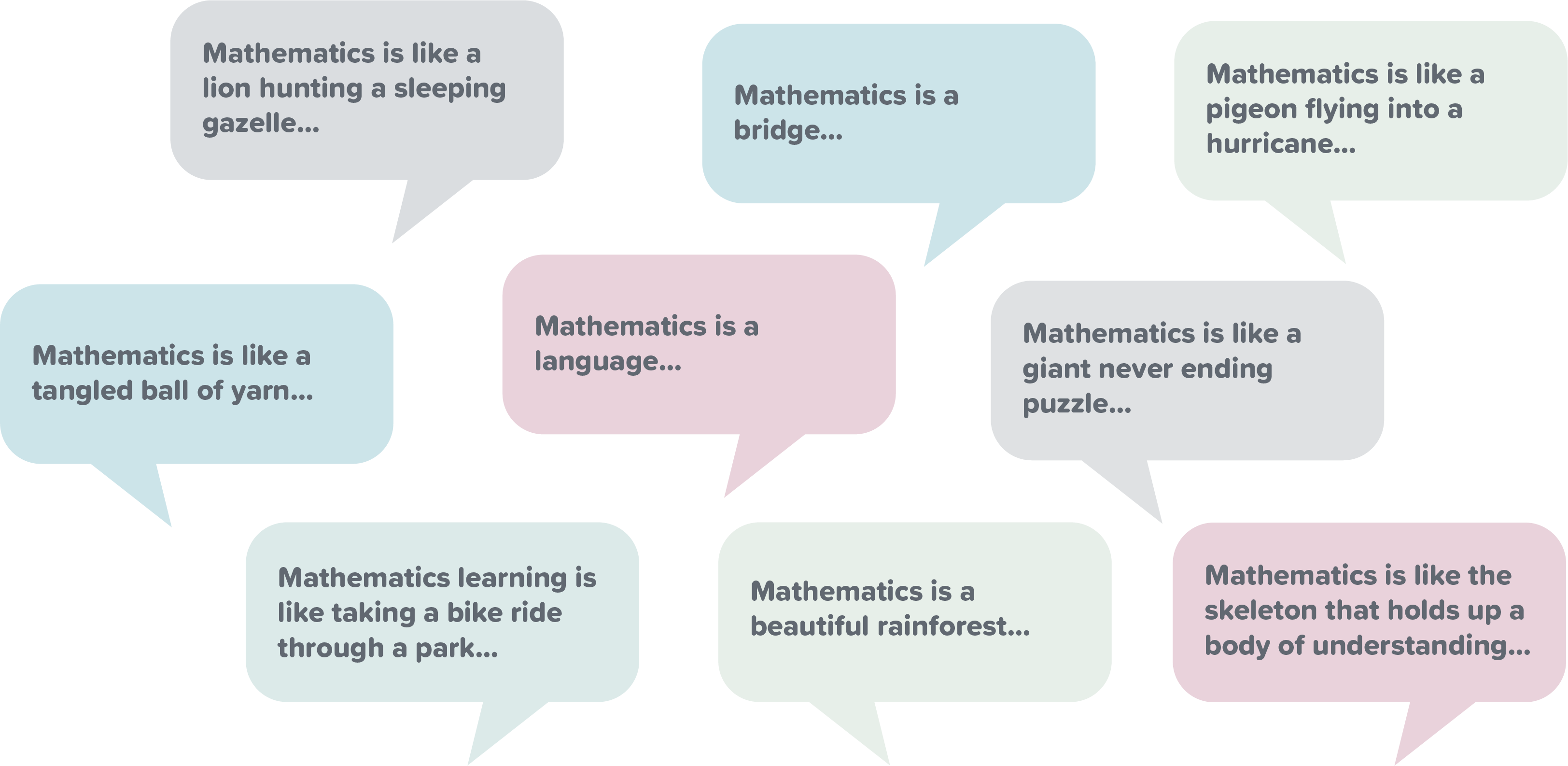I’m often struck by the different ways that we think (and talk) of and about mathematics. I suspect it is true that for many of us our perception of mathematics and mathematical activity remains implicit, below the surface, invisible and unspoken – even to ourselves – until we are faced with a specific prompt or question.
Here I encourage you to pause and to reflect on your own perceptions and ways of thinking about mathematics. You might find it helpful to consider how you would continue these sentences:
- Mathematics is…
- Mathematics is like…
- Mathematics learning is like…
- Mathematics teaching is like…
Each person I have spoken to, everything that I see and hear around me, every book and research paper that I read, seems to communicate a different, and sometimes conflicting view of mathematics. Often these views are bound up in emotion: sometimes a chosen metaphor paints a picture, and there seems frequently to be a very deliberate attempt to avoid these things – to be somehow abstract and pure in defining such views of mathematics. Interesting also is the alignment, or indeed misalignment, of views and perceptions as they apply to mathematics, mathematics learning, and mathematics teaching.
Below are a few memorable examples of phrases, and/or metaphors, that have been used by learners, practitioners and researchers to refer to mathematics or mathematical activity. Many of these came to my attention through the work of Sterenberg (2008) and Latterell and Wilson (2016 & 2017). I invite you now to consider the associations that you make, the mental images that they conjure, and the feelings they evoke for you. You may also like to add other words and phrases to the collection.

Metaphors and analogies offer useful, and often particularly memorable ways, to describe our perception or understanding of mathematics. They allow us to emphasise, suppress and organise features of mathematics in ways that have meaning to us, and they can communicate something new and surprising, opening our eyes to an alternative perception. As Sterenberg (2008) says, “metaphors have the power to shift our understandings of reality as new links between the idea and the object are considered” (p. 91). But of course, this is only possible if the chosen metaphor relates in a meaningful way to the lived experience of the reader.
Here at Cambridge Mathematics, we have made a very deliberate choice to represent ideas in mathematics spatially, creating networks with nodes and edges. Also discussed by Rachael Horsman in her blog The Cambridge Mathematics landscape of mathematics, we have consciously adopted language and terminology that characterises what could be an abstract network as a landscape to be explored. Nodes are described as “waypoints,” edges/connections are described as “paths,” and these paths are characterised further with “themes” that add richness and colour to the terrain.
But who is “exploring the landscape” that we have mapped? What might “exploring” mean for a learner, a teacher/practitioner, a designer, a curriculum developer?
This conversation has come to the fore as we have been designing professional learning resources and experiences for mathematics teachers/practitioners. Key to this is how we perceive mathematics teaching and the role of the practitioner. Thinking back to the questions I posed at the beginning of this blog, if I asked you now to insert into the sentence below one word from the list, which would you choose and why?
“Mathematics teaching is like…”
- delivering
- navigating
- exploring
- steering
- training
- guiding
For me, an experience of exploring a mathematical landscape is one where I have the freedom to follow new paths to see where they lead and to explore unfamiliar terrain. I look at concepts differently depending on where I have been, what I am doing, and where I am going. I am wandering and wondering about what I can see, hear and feel. Sometimes I am looking out for something; maybe I am searching for something that I thought I glimpsed out of the corner of my eye. Sometimes I have a destination in mind, and then I am curious about how I might get there from here, what happens and what I encounter as I walk a path. This whole experience is for me. It is valuable for me. It is also useful to me because it empowers me to craft bespoke and meaningful journeys through that landscape, ones that I could share with others.
Very soon, we will invite you to join us – to explore the new Cambridge Mathematics JourneyMaths website and its associated resources in a limited-participation pilot study of our beta version. This is an exciting time for us; we hope that the metaphors we have chosen and the experiences you have in your explorations will be interesting, enjoyable and valuable, as they certainly have been for us. Most importantly, we would like you to be an active part of our design and development process – we’d like to talk to you about your exploration and invite you to challenge our expectations and so help to make this the best resource it can be.
If you would like to participate in our closed beta, please enter your details here.
References:
- Latterell, C. M., & Wilson, J. L. (2016). Math is like a lion hunting a sleeping gazelle: Preservice elementary teachers’ metaphors of mathematics. European Journal of Science and Mathematics Education, 4(3), 283–292.
- Latterell, C. M., & Wilson, J. L. (2017). Metaphors and mathematical identity: Math is like a tornado in Kansas. Journal of Humanistic Mathematics, 7(1), 46–61.
- Sterenberg, G. (2008). Investigating teachers’ images of mathematics. Journal of Mathematics Teacher Education, 11(2), 89–105.
Join the conversation: You can tweet us @CambridgeMaths or comment below.